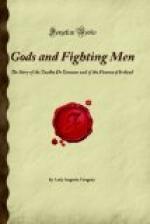In a later part of the pamphlet Mr Nutt discusses such questions as whether we may look for examples of third-century customs in the stories, what part of the stories first found their way into writing, whether the Oisin and Patrick dialogues were written under the influence of actual Pagan feeling persisting from Pagan times, or whether “a change came over the feeling of Gaeldom during the fourteenth and fifteenth centuries,” when the Oisin and Patrick dialogues in their present form began to be written. His final summing-up is that “well-nigh the same stories that were told of Finn and his warrior braves by the Gael of the eleventh century are told in well-nigh the same way by his descendant to-day.” Mr Nutt does not enquire how long the stories may have been told before the first story was written down. Larminie, however, whose early death was the first great loss of our intellectual movement, pushes them backward for untold ages in the introduction to his West Irish Folk Tales and Romances. He builds up a detailed and careful argument, for which I must refer readers to his book, to prove that the Scottish Highlands and Ireland have received their folk-lore both from “Aryan and Non-Aryan sources,” and that in the Highlands there is more non-Aryan influence and more non-Aryan blood than in Ireland. He argues that nothing is more improbable than that all folk-tales are Aryan, as has sometimes been supposed, and sums up as follows:—
“They bear the stamp of the genius of more than one race. The pure and placid but often cold imagination of the Aryan has been at work on some. In others we trace the more picturesque fancy, the fierceness and sensuality, the greater sense of artistic elegance belonging to races whom the Aryan, in spite of his occasional faults of hardness and coarseness, has, on the whole, left behind him. But as the greatest results in the realm of the highest art have




